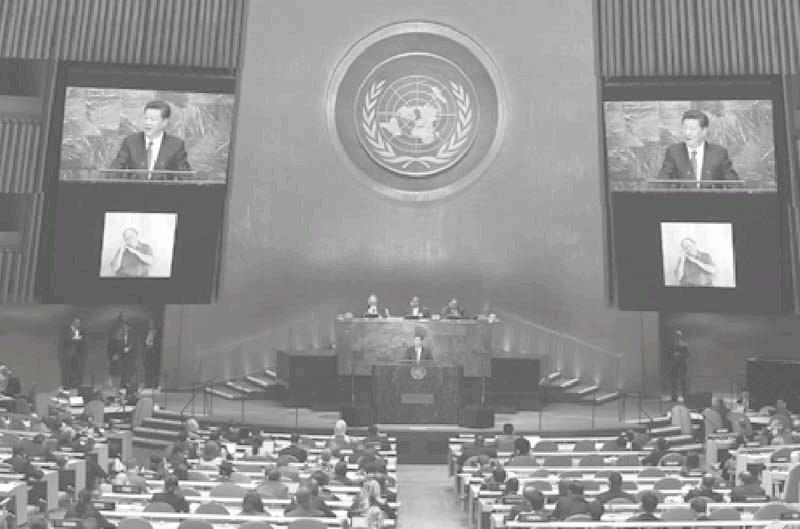China Pledges $2bn for De veloping World
Chinese President Xi Jinping has pledged to establish a 2-billion-US-dollar fund to assist developing countries and to significantly increase investment.
Addressing a UN summit on development goals, Mr Xi said investment would reach 12 billion US dollars over the next 15 years and China would cancel debts to the worlds least developed nations, including small island nations.
Beijing, he added, would assist in 600 overseas projects in the next five years and offer more scholarships.
“Looking around the world, the peace and development remain the two major themes of the times,” the Chinese leader said at the summit in New York.
“To solve various global challenges, including the recent refugee crisis in Europe, the fundamental solutions lie in seeking peace and realising development.
“Facing with various challenges and difficulties, we must keep hold of the key of the development. Only the development can eliminate the causes of the conflicts,” Mr Xi said.
His pledges of aid give a big boost to the launch of the UNs new Global Goals for Sustainable Development - the day after all members states committed themselves to a hugely ambitious programme.
The plan aims to eradicate poverty and hunger by 2030. It was Chinas extraordinary record shifting so many families out the ranks of the poor which ensured that the overall global record in poverty reduction under the previous Millennium Development Goals was substantial, our correspondent says.
But it was very patchy, he says, adding that now China is offering to help other countries, particularly in Africa, make the same transformation.
This new initiative also suggests China is willing to take on more of the responsibilities that go with its status as emerging superpower.
Beijing Tops Chinas Hourly Minimum Wage
Beijing set its minimum wage standard at 18.70 Yuan, or 2.9 US dollars, per hour from September 28, the highest in the country, the Ministry of Human Resources and Social Security (MOHRSS) announced recently.
Chinas northeast Heilongjiang provinces minimum wage of 11 Yuan per hour makes it the lowest in the country, according to the MOHRS.
Meanwhile, the southern city of Shenzhen set the highest minimum monthly wage at 2,030 Yuan, while Heilongjiang had the lowest minimum monthly wage of 1,160 Yuan per month.
Nineteen regions on the mainland increased their minimum wage at an average rate of 14.1% in 2014, said the MOHRSS, adding that growth was faster than the planned annual average growth rate, but slower than the previous three years.
China is expected to achieve its average annual minimum wage growth target of 13% for the five-year period ending in 2015.
City and provincial governments have the authority to set the minimum wage standards, 27 regions raised the minimum wage by an average of 17% in 2013, while minimum wage hikes in 25 regions surpassed 20% on average in 2011 and 2012.
Wuhan Opens Communist Party Theme Park
Wuhan, the capital city of Chinas central Hubei province just opened a Communist Party theme park dedicated to Chinas homegrown heroes.
Opened to the public on September 28, its located inside the 300,000-squaremeter South Lake Happiness Bay Water Park. The park is dotted with the faces and stories of 29 “excellent party figures” on bronze plates and 23 artworks highlighting significant moments from Chinese Communist Party history between 1921 and 2014.
Its just one of six parks the city has planned to promote patriotism and party ideals. The focus of this particular park will be on the people of the Communist Party.
Described by state media as an enjoyable “red benefit” for the citys residents, the new attraction is the biggest communist-themed park in Central China.
The events are depicted in installations inspired by the traditional Chinese art form of paper-cutting.
Red tourism is big business in China. Here, tourists dress up as Red Army soliders during an educational tour in Jinggangshan, the birthplace of the Chinese revolution.
The park consists of four display areas with different highlights and minithemes.
And it isnt shy about its purpose of indoctrinating the young with communist ideology.
One of the attractions is a square where students and youngsters can take an oath to join the Communist Youth League or become party members.
The childrens playground features adorable cartoon figures of Red Army soldiers, while the ground is decorated with a map of the partys famous Long March.
The Long March was a military retreat led by Mao and his Communist army in order to evade suppression of the Nationalist Party army in the 1930s.
The parks aim is to promote core socialist values -- including prosperity, democracy, civility, harmony, freedom, equality, justice, rule of law, patriotism, dedication and integrity.
Unfortunately, Chinese netizens dont seem to buy the idea. On Chinas microblogging site Weibo, user Minghe-zaitian1983 says, “Schools and work units probably will organize trips there, brainwashing kids and enhancing employeessense of identity with the party.”
Quanjiushiyi thinks its just an attempt by the Wuhan government to please Beijing. “I hope nobody will go! Its an advanced brown-noser.”
Yuanyuanzhong sums up the mood with: “It could be a theme park you least want to go.”
China to Set up Database for Nanjing Massacre Files
China will set up a special database and upgrade the protection of documents regarding the Nanjing Massacre after files on the atrocity were listed on the UNESCO Memory of the World Register.
A number of domestic archives will jointly establish the database, which will be open to the public at home and abroad, said a source with the Second Historical Archives of China on Oct. 11.
The database can help people learn more about the historical calamity caused by war, said the source.
Lasting more than six weeks, from December 13, 1937 until January of 1938, the Nanjing Massacre saw the deaths of 300,000 Chinese civilians and unarmed soldiers after the city fell into the hands of the Japanese.
On Oct. 09, 11 sets of Nanjing Massacre files, including film, photographs and text taken and written between 1937 and 1948, were listed on the UNESCO Memory of the World Register, despite Japans protest.
There are a large amount of archives on the slaughter from the aggressor, victims and third parties, said Guo Biqiang, a researcher with the Second Historical Archives of China.
The amount and variety of the documents were unmatched compared with similar heritage events, he said.
“China will ensure these valuable documents are protected and circulated, and make them play a positive role in remembering history, cherishing peace, looking into the future and safeguarding human dignity,” Chinese Foreign Ministry spokesperson Hua Chunying said.
Nanjing Massacre documents are mainly housed in the Second Historical Archives of China, the Nanjing Municipal Archives and the Nanjing Massacre Memorial Hall.
China to Invest 140bln Yuan in Upgrading Rural Telecommunication
On Oct. 13, China unveiled plans to upgrade its Internet infrastructure and the development of its logistics industry in rural areas, part of the governments efforts to encourage online spending among rural residents.
The telecommunication upgrade will involve investment of at least 140 billion Yuan, or 22.1 billion US dollars
An executive meeting of the State Council presided over by Premier Li Keqiang decided to allocate more central government funds to building Internet infrastructure and also advocated funding from local governments and social organizations.
A circular issued after the meeting said the government plans to invest up to 140 billion Yuan in the sector by 2020 to provide at least 50,000 villages with Internet access. By then, about 98% of the nations rural areas will be hooked up to the Net.
The government also promised to improve Internet speed and expand wireless broadband coverage in areas with access to the Net.
Estimates of Chinas rural population range from 600 million to 800 million.
The meeting also pledged to expand e-commerce apps in rural areas, especially in promoting agricultural products and trips to the countryside.
The government will also open up the delivery industry to social investors, encourage mergers and acquisitions, and streamline customs procedures for crossborder deliveries.
Zeng Chen, an e-commerce expert at the Ministry of Commerce, said online shopping revenues topped 9.8 trillion Yuan from January to August, a year-onyear rise of 24.7%.
“There is a large market for ecommerce in rural areas and small and medium-sized cities in western China, where residents need the same goods as their urban counterparts but have limited access to such products,” Zeng said. “Ecommerce revenues in third-and fourthtier cities have shown stronger momentum than in big coastal cities, and we expect increased growth in these areas when local logistics are improved.”
Cross-border e-commerce and shopping conducted via mobile devices are the new growth points for the industry.
Chinese spent about 90 billion Yuan last year on mobile phones and other mobile devices, comprising one third of the total they spent online.
More than 80% of export and import companies in China have opened online businesses.
Most Chinese Cities Fail to Meet Air Quality Standards
About 80% of Chinas 367 cities with real-time air quality monitoring failed to reach national standards on small particle pollution in the first three quarters of the year, according a latest report from Green Peace.
Central Chinas Henan province had the highest daily concentration of health endangering PM2.5 — particulate matter with a diameter smaller than 2.5 microns— during the period, the report said. Beijing ranked second.
The report released by Green Peace, a nonprofit environmental organization, said it relied on date from the China National Environment Monitoring Center, which updates air quality data hourly on PM2.5 and PM10 concentrations in the 367 cities.
Seven cities from Hebei province filled spots in a list of 10 with severe air pollution during September, the national environment watchdog said.
The Ministry of Environmental Protection released its monthly report on the air quality of 74 major cities on Oct 14, among which seven in Hebei including Hengshui, Tangshan and Shijiazhuang, were listed as having heavy air pollution.
Jinan in Shandong province ranked as the worst with Zhengzhou from Henan province second worst, the report said.
Although residents of the seven cities in Hebei witnessed heavy smog last month, the air quality in the BeijingTianjin-Hebei region has seen an improvement.
In the trilateral zone, the concentration of PM2.5 – particulate matter with a diameter smaller than 2.5 microns – has been lowered by 26.2 percent year-onyear, said Luo Yi, head of environment supervision of the ministry.

